Example of Line and Balance Example of Form and Movement in Art
Within: The ultimate drove of principles of blueprint examples and definitions, plus helpful resources for teaching the elements and principles of art.

What are the Elements and Principles of Art?
The elements of fine art and principles of design are the fundamental pieces that make upwardly an artwork. Virtually works of art volition make employ of many or all of the elements and principles of fine art. We ofttimes guess art by how finer the creative person used these design fundamentals fifty-fifty earlier we acquire about them.
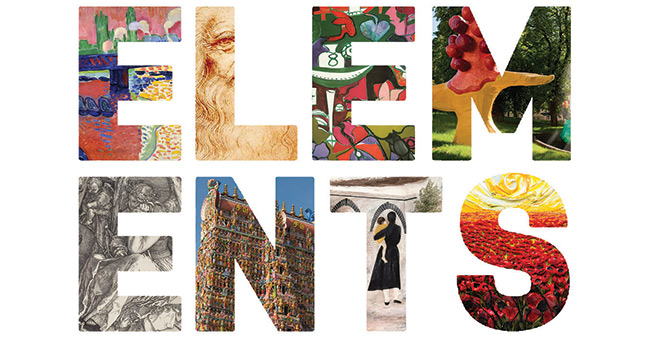
The elements of fine art are the edifice blocks of an artwork: color, line, shape, form, value, texture, and infinite. They are the tools artists apply when creating an artwork. Run into Elements of Art Examples and Definitions for more than on the elements of art.
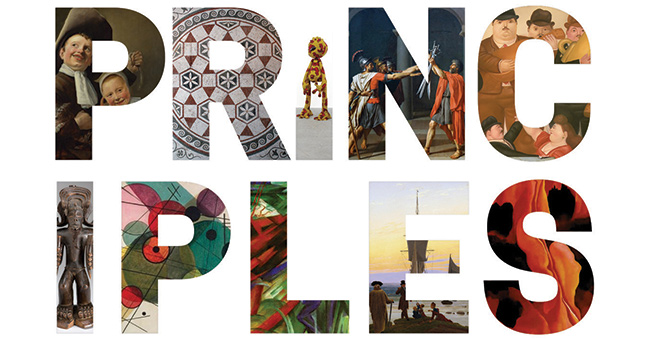
The principles of design are how those building blocks are arranged: contrast, rhythm, proportion, balance, unity, emphasis, movement, and variety. They are the means an artist can organize the elements of art to create a wide range of furnishings.
Each of these art fundamentals are closely related and many of them overlap. When combined, they produce a complete artistic vision.
Why are the Elements and Principles of Art Important?
Knowing the elements and principles of art boosts visual literacy. Artists and creators make more powerful works when they utilize the principles of art. When viewers are familiar with the elements of art, they become more enlightened of the details and can meliorate capeesh what they come across and the bulletin behind information technology. Connecting with art makes us more compassionate and strengthens the textile of society. In the age of the internet, agreement how and why advertisers brand blueprint decisions can empower students with information and make them less susceptible to manipulation.
Teaching the Elements of Art and Principles of Design
I in one case said that I hate the elements and principles of fine art, but that's not quite accurate. The elements and principles of fine art are a lens through which to view and understand art, but they are not what makes art education vital. Art inspires higher level thinking, focus, a growth mindset, visual literacy, curiosity, respect, and connection. The elements and principles of pattern are an artist's toolbox. Knowing the tools non only improves students' studio art skills and gives them deeper appreciation when viewing artworks, it helps make them ameliorate, more than informed citizens and prepares them for a visually circuitous and culturally interconnected mod world in need of creative problem solvers.
Below yous'll find an caption of each of the principles of design, including artwork examples and links to helpful materials for teaching the individual concepts.
Delight notation, this postal service includes Amazon affiliate links. Every bit an Amazon Associate I earn from qualifying purchases.
Download the Gratis Elements and Principles Printable Pack

This pack of printables was designed to piece of work in a variety of ways in your classroom when teaching the elements and principles of art. Yous tin can print and hang in your classroom every bit posters/anchor charts or yous tin cut each element and principle of art in its own private card to use as a lesson manipulative.

Principles of Design Examples and Definitions
Scroll below for each element or click the link to be taken to the appropriate principle of pattern:
- Contrast
- Rhythm
- Proportion
- Balance
- Unity
- Emphasis
- Movement
- Variety
Contrast
As a principle of art, contrast refers to the arrangement of opposite elements and effects. For example, light and dark colors, smoothen and rough textures, large and modest shapes. Contrast can exist used to create multifariousness, visual interest, and drama in an artwork.
In this example of dissimilarity in art, Caravaggio created a scene of activity and energy by contrasting both lite/nighttime and directional lines.

Käthe Kollwitz adds contrast using the elements of art line, value, and shape, simply she likewise adds contrast of emotion showing the despair of the female parent in nighttime values and lighter sweeter elements similar the heart on the chair in the groundwork.

Dissimilarity in Fine art Resources
- The Paper Manufacturing plant Store: Design Principles, Dissimilarity
- Jon Lovett: Dissimilarity, Principles of Design
- Edvard Munch Fine art Lesson with Project
- Judith and Holofernes Paintings: A Compare and Contrast Art Lesson
Rhythm
Rhythm is a principle of design that suggests movement or action. Rhythm is unremarkably achieved through repetition of lines, shapes, colors, and more than. Information technology creates a visual tempo in artworks and provides a path for the viewer's centre to follow.
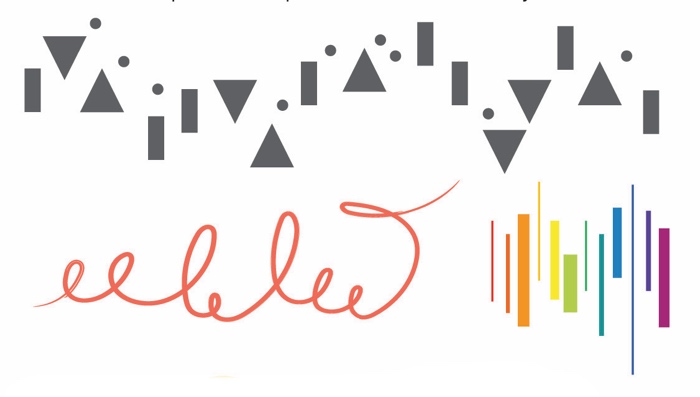
In this rhythm example, the creative person uses design, repetition of line, and contrast between curved and straight lines to create rhythm in art.

In this case of of rhythm in art, Mondrian repeats shape, color, and line to bounce the viewer'south eye around the artwork.

In this fun rhythm in art examples video, the differences between design, repetition, and rhythm are described and put to music.
Rhythm in Art Resources
- Fine art Soup Video: Principles of Blueprint: Rhythm
- Horse in Motion & The First Moving Pictures
- Early on Photography Inspired Flipbook Project
Proportion
Proportion is the size relationship betwixt the various parts of an artwork. Artists can use the scale and proportion to create sensations such as depth, realism, disorientation, and drama.

The human being effigy is scaled to appear larger than the metropolis skyline. The proportions could indicate depth of perspective or could symbolize the relationship of laborers in building a city.
In this example of proportion in art, the artist manipulates the private proportions of the child also as create varying size relationship (scale) between the objects in the painting and the child to create meaning in the artwork.
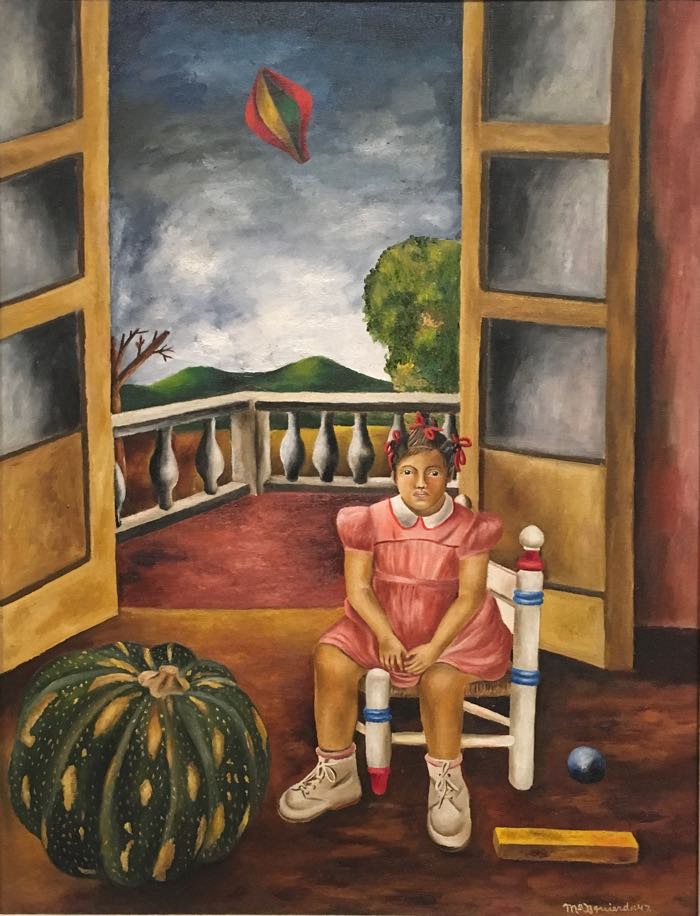
In this proportion in art example, the creative person make the hands out of proportion with the rest of their bodies to enhance the meaning of the artwork. These men work with their hands, and their hands are exaggerated to prove how important their hands and work are to all the people of France.

Looking for more than examples of proportion in art? Check out The Ultimate List of Proportion and Scale in Art Examples post!
Calibration
Scale in art describes the size of one object in relation to another and too refers to our perception of perspective and proportion. Artworks that expect realistic are scaled similarly to real world objects. Scale in art tin can likewise refer to the overall size of the work.
In this scale in fine art example, the artist uses scale to show the space or depth between the girl and the house in the groundwork.

In this example of scale in art, Magritte plays with calibration to create an amusing limerick.

Hierarchical Scale
Hierarchical scale is a technique used in art, most often in sculpture and painting, in which the artist depicts objects with an unnatural scale to show their importance or lack thereof. This size manipulation draws the viewer'due south eye where the artist wants attention.
Ancient Egyptian artists are well-known for their apply of hierarchical scale. In this example of hierarchical scale in art, the artist shows the man as largest (most important) and the kid smallest (least important). The figures are in proportion inside the figure but out of proportion with the other figures in the picture.

For more than examples of scale in art, check out our proportion and calibration in fine art blog post!
Proportion in Fine art Resources
- The Ultimate Drove of Proportion in Art
- How Artists Depict Space
- Art Effectually the World in 30 Days – Solar day #24 – Columbia's Fernando Botero
- Sophia.org: Design in Art: Scale and Proportion
Residual
As a principle of art, residue refers to the distribution of weight in a composition. While actual weight is a factor in sculpture and architecture, the principle of remainder most often refers to the visual heaviness of shapes and forms in an artwork. An artwork's residual affects the equality and tension of the limerick and tin can lend a feeling of calm or chaos to the piece of work.

Symmetrical Residuum
An artwork with symmetrical balance is well-balanced and looks even and stable. When one side of an artwork mirrors the other, it has absolute symmetry. When the symmetrical residue is not exact, it is called bilateral symmetry.
In this example of symmetrical residuum in fine art, each animal on the left has its equal analogue on the right. The colors are not exact, but it is withal considered symmetrical residuum.
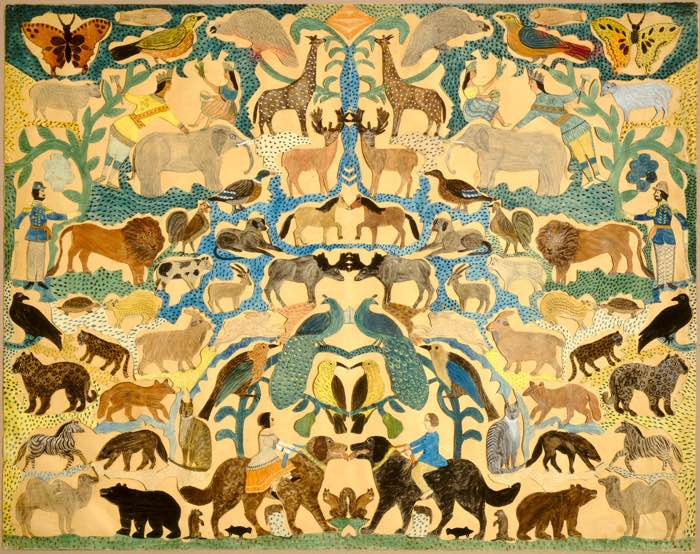
Asymmetrical Rest
An artwork with asymmetrical balance is "heavier" or "lighter" in some areas, looks unstable, and can make the viewer uncomfortable. Asymmetric balance adds a dynamic await to artworks and often draws attention to focal points in the limerick.
In this case of asymmetrical balance in art, the creative person balances the heavy blackness figure on the right with the pall on the left. If the mantle were a different size or a different color, the rest would be thrown off.

Radial Balance
An artwork with radial balance is arranged around a primal component. Forms and objects in a radially balanced composition appear to radiate out of the round focal point of the artwork.
With radial residue, like in the example of radial balance below, one tin imagine the artwork as equal pieces of a pie.

Looking for more than examples of residue in art? Check out The Best Examples of Rest in Fine art post!
Residuum in Art Resources
- The Ultimate Drove of Balance in Art
- Bully Mag: Design Principles: Compositional, Symmetrical, and Asymmetrical Balance
- Lifewire: Balance: The Bones Principles of Pattern
Unity
Unity, besides known as harmony, is a design principle that refers to the cohesiveness of an artwork—how whole, consequent, and consummate it appears. Unity in fine art is not necessarily simply a repetition of the same element over and once more, simply it is the pleasing combination of elements to create a harmonious composition.
In this example of unity in art, Botero creates unity through subject matter, through rhythm, and through repetition of class, shape, and color.

In unity blog postal service, you lot will find more examples of unity in fine art created with shape/form, color, texture, line, style, and in architecture.
Unity in Art Resources
- Examples of Unity in Art
- Natomas High Schoolhouse Design Department
- Virtual Art Instructor: Teach harmony and unity with a game
Accent
Every bit a principle of fine art, emphasis refers to the expanse of an artwork that dominates attending or draws interest. Information technology is frequently the place a viewer looks kickoff. Artists create emphasis past contrasting the elements of fine art, such equally color or shape.

In this case of emphasis in art, Goya highlights the man in white through putting him in a spotlight, having the human being wear bright clothes, having many lines throughout the composition pointing to the man, and having his emotional confront be one of the merely faces shown.

Looking for more examples of emphasis in art? Bank check out The All-time Examples of Emphasis in Art post!
Emphasis in Fine art Resources
- The Ultimate Collection of Accent in Art
- Sophia.org: Design in Fine art: Accent, Multifariousness, and Unity
Movement
Movement can be thought of in two ways – the starting time refers to how an artist depicts movement using the elements and principles of art. The 2d way refers to the visual flow of an artwork, indicated by the path a viewer'due south eyes take equally they await at the artwork.
Lines, edges, shapes, and colors can exist utilized by the artist to signal the manner through an artwork every bit a map for our eyes to follow.
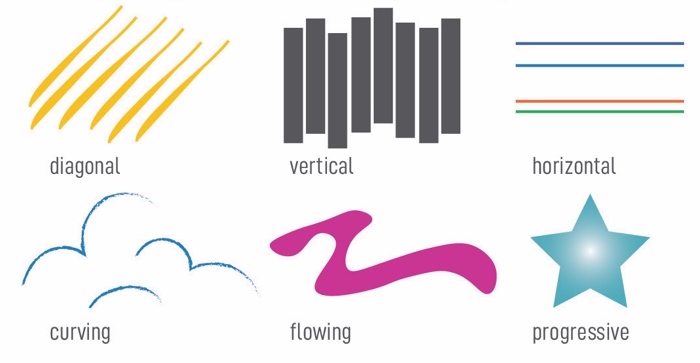
In this example of movement in art, the creative person shows the motion of the wind through the shapes of the paper. The lines of the figures and the lines of the billowing clothing convey movement in art as well.
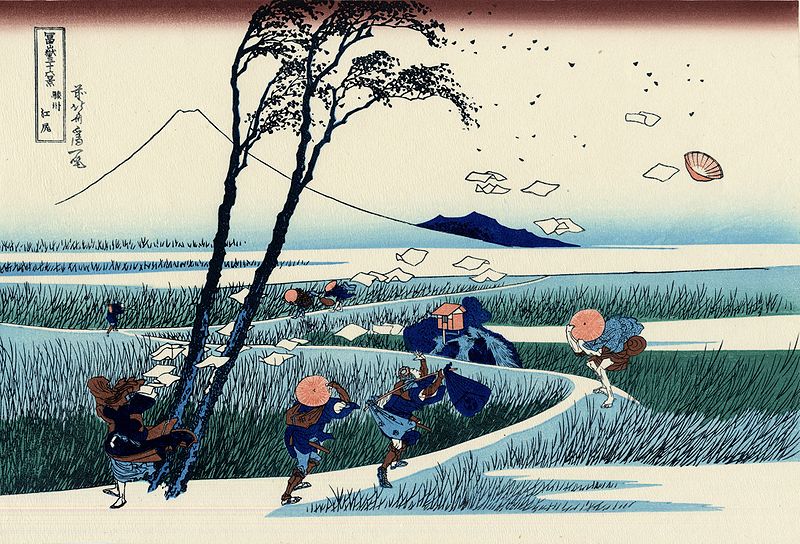
Motion in Art Resources
- Art, Design, and Visual Thinking: Movement
- Art Almost Dearest: Oskar Kokoschka's The Bride of the Air current
- Fate of the Animals by Franz Marc
Diverseness
Variety refers to the elements of a composition that differ from one another. Variety creates visual interest and free energy.
A lot of multifariousness can brand an artwork await busy or overwhelming. When paired with unity, multifariousness offers the viewer points of involvement.
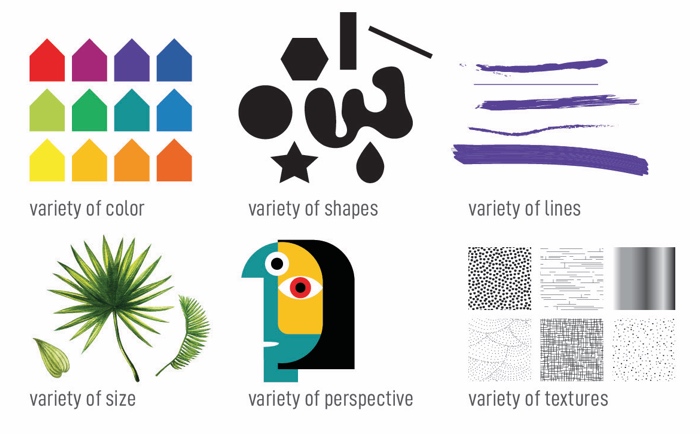
In this instance of variety in art, Kandinsky uses a multifariousness of lines, shapes, values, and colors.
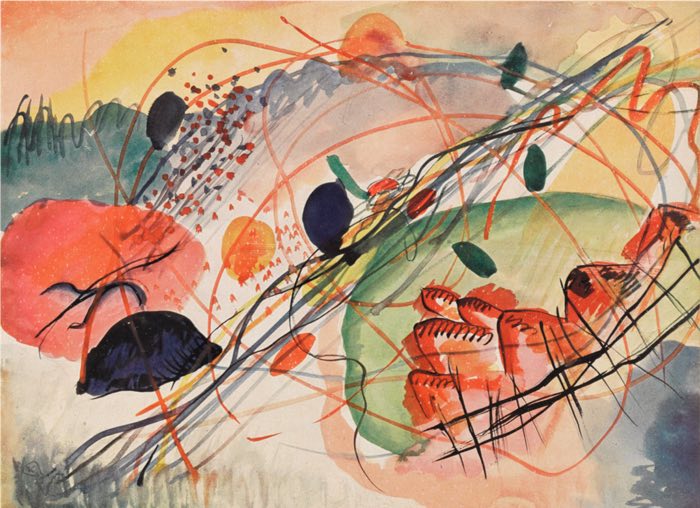
Variety in Art Resources
- The Virtual Teacher: Diversity, Harmony, and Unity
The principles of design examples tin can be a powerful style to engage and interpret a work of art. To assistance your students appoint, don't forget to download these free art worksheets:

Free Worksheets
8 Gratis Art Appreciation Worksheets
includes the Elements & Principles!
Download eight Free Art Appreciation Worksheets – including ii Elements and Principles pages! Activities designed to work with almost whatsoever work of art. Help your students connect with art while having fun!
More than Principles of Blueprint Examples
For more examples of elements and principles of art, bank check out more from our elements of art examples serial below.
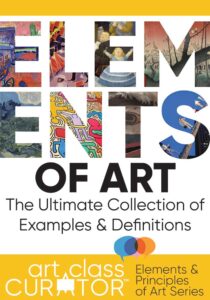
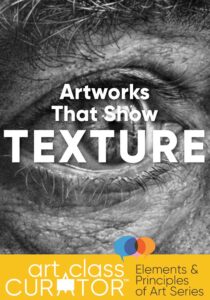

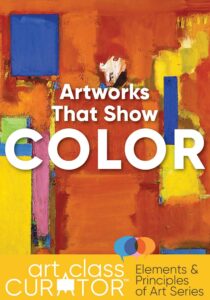

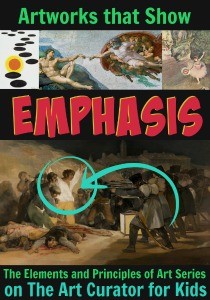


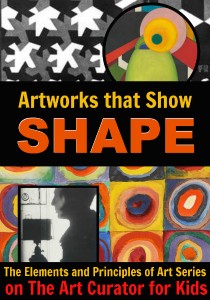
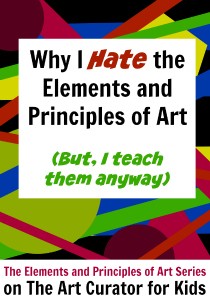
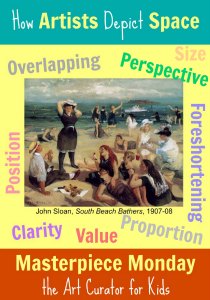
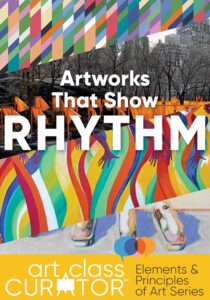
woolcockyousagannot.blogspot.com
Source: https://artclasscurator.com/principles-of-design-examples/